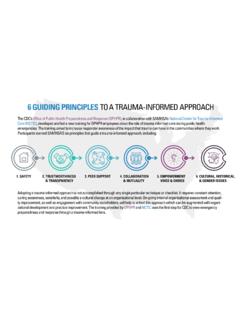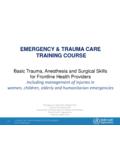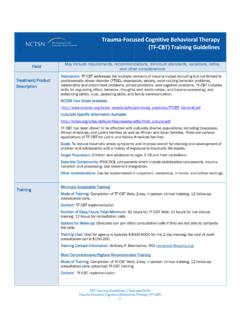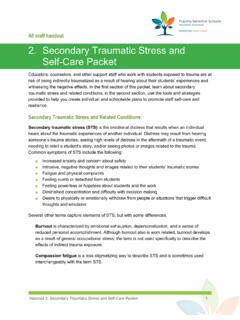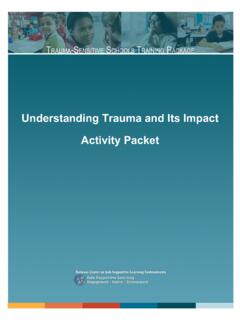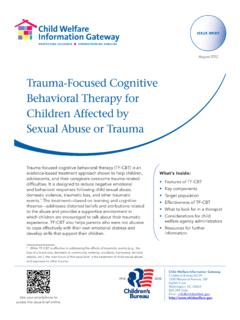Transcription of TRAUMA TRAINING FACILITATOR S TOOL KIT
1 TRAUMA TRAINING FACILITATOR S TOOL KIT By Kris Downing, Communities In Schools of Central Texas, with support from the Research to Practice Grant from CIS National, Megan Walker Grimaldi and Aimen Khan 1 TRAUMA TRAINING for Educators FACILITATOR s Tool Kit Contents: Section One: FACILITATOR s Guide Tips for Using This Tool 2 Slides and Video TRAINING Activity Ideas Before and During the 6-8 Post-Video Discussion 9 Sample Introductory Letter to 10 Section Two: Handouts for Teachers General TRAUMA Overview ..12-16 Classroom Common Questions and Concerns from Basic Needs of Students: Safety, Belonging and 22 STEPS / Strategies for Building 23 General Guidelines for De-Escalating a TRAUMA Informed Accommodations / Ideas for Creating a Classroom Calming 26-27 Time In Poster / Mindfulness Benefits and Sample Mindfulness 30-31 Grounding / Centering Script for 32 Green/Yellow/Red Zones: Helping Students Assess Their Section Three: Free TRAUMA -Related Resources 2 Tips for Using This FACILITATOR s Tool Kit Prepare To Present: First, be sure to view the 43 minute video before facilitating it with a group.
2 It is ideal if you can find a teacher or counselor on campus who is an advocate for TRAUMA TRAINING , to help you review and plan the presentation and handouts, advocate for getting time on the faculty agenda, and co-present with you. Consider your time and audience: Pick and choose which Activities and Post Video Discussion Questions you want to use. It is recommended to share at least 3-4 activities during the video that will allow time to pause and reflect on the information. This will deepen the learning and allow educators to relate the information to their personal experience. Emphasize that some strategies may be easier than others: This will depend on a teacher or administrator s comfort and style.
3 One strategy, slowing down and using a soft tone of voice, is the most effective means for us to communicate safety in a school setting. So give this extra attention since touch may not be a comfortable option, and may be a TRAUMA trigger for students if we don t have a strong and safe relationship with them. Choose which handouts to copy and share: Base your choices on the needs of the group as well as your level of comfort with the handout information. For example, the grounding script is something that teachers can use in class; the picture / words poster for grounding can be laminated and put up in a calming corner ; and the TRAUMA Informed Accommodations can be important additions to 504 Plans and BIPS.
4 If possible, review your handouts with faculty after the TRAINING , and discuss how they might be used. Follow-up with Your Audience: Specific content sections of the video, handouts and articles may be shared throughout the year, for on-going discussion groups, or mini TRAUMA presentations. Consider an Engaging Introduction: This short 5 minute video provides a GREAT introduction to the TRAINING : 3 Slides and Video Content This is a visual guide to each slide in the video. A slide is one click forward, but may contain multiple pictures, backgrounds and other media. Allow the slide bar to play through to the end before pausing for an activity.
5 Scenarios of Common Disruptive TRAUMA -Response Behaviors (6 slides) Goals of TRAUMA TRAINING for Educators (1 slide) What do we mean by TRAUMA vs. Everyday Stress? (1 slide) PTSD and Automatic Survival Responses: Fight, Flight, Freeze (3 slides) Single Event TRAUMA (3 slides) Activity #2 Complex TRAUMA : Different Types (1 slide) Developmental TRAUMA , Impact on Early Brain Development (4 slides) 4 Dissociation / Freeze (1 slide) Activity #3 Bullying / School-Based Relational TRAUMA (1 slide) Understanding and Responding to Student Overwhelm (3 slides) Guided Exercise: Recalling a Difficult Memory (3 slides) Activity #4a Guided Exercise in Grounding.
6 Somatic Responses (3 slides) Activity #4b How Our Brain Stores Memories (1 slide) Sensory Triggers and Perception (1 slide) Activity #5 The Triune Brain: Neurobiology of TRAUMA (1 slide) Activity #6 5 Window of Tolerance (1. 5 slides) Pause Midway: Activity #7 Effects of Untreated Complex TRAUMA (last 1/2 of slide above) ACES Study (1 slide) Growing New Neural Pathways: Co-Regulation (1 slide) Activity #8 STEPS to Build Safety for the Traumatized Student (1 slide) Revisiting the 6 Scenarios When Applying STEPS (6 slides) Activity #9 Classroom Strategies (2 slides) Activity #10 Review Strategies That Activate Survival Brain or Thinking Brain (1 slide) Recognizing a TRAUMA -Response and When to Problem Solve (2 slides) 6 TRAINING Activity Ideas Before and During the Video Pause at the end of the slide for the activity.
7 Choose 3-4 activities for a 90 min. presentation. 1) Before starting the video, have participants partner up and each take JUST ONE MINUTE to share a feel good experience that happened recently give only the newspaper headline version. Ask: What changed for them physically (breath, muscles, temperature) by just talking about it. Then show the 4 min. You Tube Video Ask: What did the children say that they needed? 2) Single Event TRAUMA Slide: Emphasize that many people recover naturally from a single event TRAUMA , through the help of their personal support systems. But if TRAUMA related symptoms persist, such as intrusive thoughts, trouble sleeping or eating, stomach aches / headaches / backaches, frequent sweating or heart palpitations, feeling fearful or easily startled, then TRAUMA Informed Therapy such as TRAUMA -Focused Cognitive Behavioral Therapy is important for recovery to avoid on-going symptoms of post-traumatic stress.
8 3) Dissociation Slide: Discussion: Who has experienced a person that dissociated (complete shutdown)? Often times restraints, post extreme rage, or sudden actions will trigger dissociation. What did you do to help bring the person safely out of their dissociative state? a. Get someone to take them to a quiet place, no interruptions, reduce stimulation (light / sounds), use a calm voice, Take all of the time that you need. and I m right here. b. As the student begins to return to the present: allow them to slowly orient around the space. Offer a glass of water, and a pillow or a blanket to hold and help warm them up. c. Normalize: It seems like you needed some quiet time.
9 Share how you see them coming back into the present: I notice you re looking around and your eyes are brighter. d. When they are ready to move, take a few breaths together, help them stand up slowly, walk slowly offering them support and help them orient (Example: We are in the counselor s office right now I like her picture of the waterfall. ). Don t rush. 4) 4a 4b Guided Experiential Slides. Have volunteers share what changed in their bodily sensations after the first experiential part holding an unpleasant memory - before going to the 1st body slide. (ask them NOT to share the content of the memory ONLY the physical changes).
10 Then have them share what changed in their body after the grounding did anything shift or change? Share out before going to the 2nd body slide. 7 5) Sensory & Perception Slide: Internal and external sensory triggers. Discuss false associations a neutral sensory stimulus (something you see, hear, smell, taste, touch, or feel) that triggers the student s memory of the TRAUMA and produces an automatic threat response. a. Activity: Identify the Neutral Stimuli that may be a Trigger in School: Share the example of a child who has a father who is an alcoholic, and often gets violent and abusive with the mom and children when he s been drinking.

